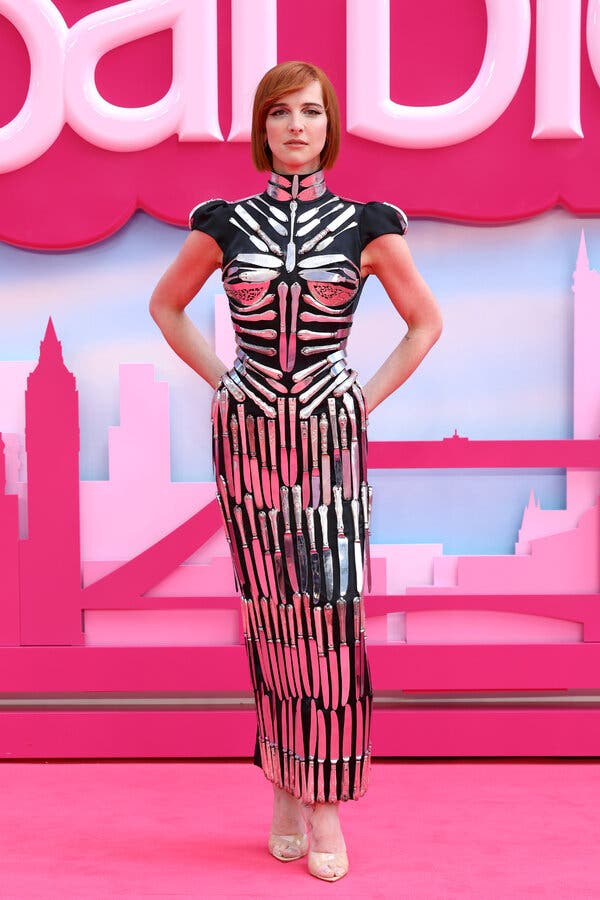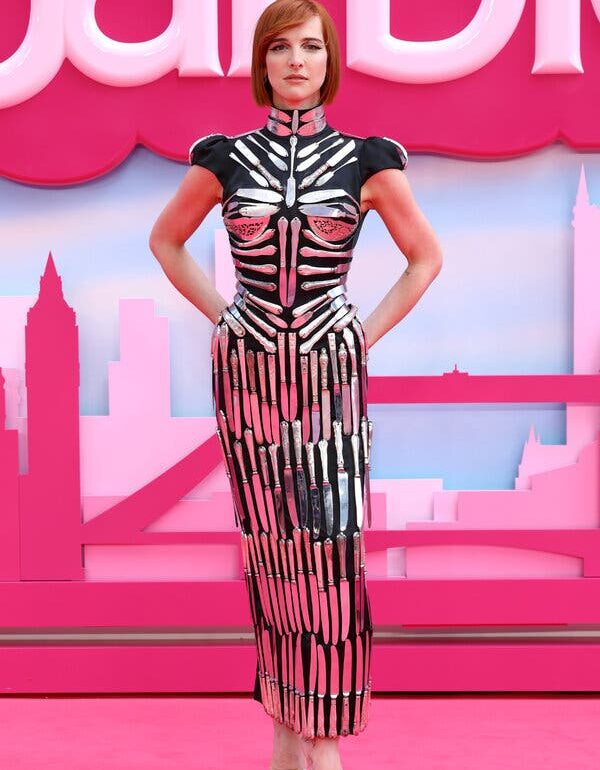Dilara Findikoglu had the kind of summer most emerging designers could only dream of.
She dressed Margot Robbie in a racy strapless dress to the “Barbie” premiere after-party in London, one of the most high-profile red carpets of the year. Kylie Jenner pouted on Instagram in a red silk bra and champagne-colored corset and matching miniskirt, and Zendaya posed for Elle in a mohair bikini. At the MTV Video Music Awards, Cardi B wore a custom gown and matching cuffs made from thousands of silver hair clips.
Then there was the finale look from Ms. Findikoglu’s show last season, the “Joan’s Knives” dress, inspired by a vision of Joan of Arc returning from the dead for revenge. It was fierce feminized armor forged from Victorian silver cutlery and painstakingly set onto a curve-hugging black sheath. Hari Nef wore it for its red carpet debut (to the London “Barbie” premiere). Weeks later, Emma Corbin wore it on the cover of ES magazine, an accompanying fork sticking out of her hair.
Ms. Findikoglu’s loyal fan base on social media went berserk each time she chalked up a win. Seven years after starting her namesake label, and with a recent nomination for New Establishment women’s wear designer at the Fashion Awards, she seemed tantalizingly close to tipping from fashion groupie worship into a wider consciousness.
All this was headed toward a culmination during London Fashion Week, where her show was the most anticipated on the schedule. But then, just days before the start of the shows on Sept. 15, and after months of preparation, everything changed. There would be no runway show after all.
Over a Zoom call earlier this week, Ms. Findikoglu said she was sitting out the season, though not because of the anarchic streak for which she is known. She had to cancel the show, she said, if she wanted to keep her business afloat.
“This wasn’t something I wanted to do or a decision I took lightly, but the reality is we simply don’t have the finances for a runway show right now,” she said. Her label, which she has wholly owned from the beginning, needed investors. As fashion week loomed — and despite the surrounding hype — the task of balancing the books became more ominous. Eventually, she said, she realized that she should “cancel the show and use that budget in smarter ways, rather than be some delusional artist.”
“To put on a show, I have to have a brand,” Ms. Findikoglu said. “The Dilara world and all its drama doesn’t come for free. Everyone needs to be paid. With my shows, I take my brain out of my head and put it on the runway for everyone to see. If I have to do that in a halfhearted way, then all the other sacrifices stop being worth it.”
A Woman Designing for Women
Ms. Findikoglu, 33, is far from alone in the struggle to thrive in the 21st-century fashion landscape. There are mounting, often insurmountable, challenges for independent designers everywhere, especially as conglomerates like LVMH and Kering expand their portfolios and become evermore dominant in the industry.
In London, a magnet for emerging fashion talent for the last three decades, things are especially tough because of the continuing fallout of Brexit and the pandemic,
“I don’t think it has ever been more difficult to be an independent designer in London than it is at this moment,” Caroline Rush, the chief executive of the British Fashion Council, said at a news conference this week.
Once-glittering names like Christopher Kane and Nicholas Kirkwood entered administration (the British term for filing for bankruptcy) this year. Several of London’s most promising new talents, like Nensi Dojaka and S.S. Daley, had already opted out of shows this season, long before Ms. Findikoglu canceled hers. That the starriest name felt her show could no longer go on says a lot about how precarious the industry is right now.
Still, Ms. Findikoglu has always been willing to go against the grain. Brought up in a traditional household in Istanbul, she traveled alone to London at 19 to study fashion design at Central Saint Martins. When she wasn’t selected by her tutors for the prestigious graduate collection that is shown to reporters and editors, she led a crew who staged a guerrilla show outside the show site.
Her first solo show was in a strip club. The second was in a deconsecrated church, as was her most recent show, in February. Called “Not a Man’s Territory” and inspired, in part, by protests in Iran against a compulsory hijab, that show was the most potent encapsulation yet of the core themes that have driven Ms. Findikoglu’s work: anger, sex, feminism, emancipation, sorcery and history. The collection, grounded in her signature corsets and underwear, was, she said backstage, her “little dance of revolution toward women possessing their bodies back.”
Lynette Nylander, the executive editorial director of Dazed Media, described Ms. Findikoglu as a designer who thrives on challenging and provoking her audience, as did Vivienne Westwood and Alexander McQueen.
“Dilara offers up these fierce visions of female beauty and isn’t scared to go to dark places or make you feel uncomfortable to watch her doing so,” Ms. Nylander said. At the same time, the garments themselves make a wearer feel quite the opposite.
“She presents herself as this intense industry rebel,” Ms. Nylander said. “But Dilara really knows how to make her customers feel empowered in this sexy, often playful way. She is a woman designing for women.”
Ms. Nef said she had wanted to wear the Joan’s Knives dress to the ”Barbie” premiere because of the way it accentuated her waist and because it wasn’t pink, thus defying expectations.
“It is also covered in knives,” she wrote in an email. “which felt like an appropriate way to meet a moment of unprecedented visibility.”

Despite the rapturous industry response to her most recent collections, Ms. Findikoglu had been pondering new paths — at least creatively — well before she canceled her fashion week show. Tiny and dripping with gothic silver jewels, she sat at a picnic table last month outside her studio in the London neighborhood of Hackney, bathed in sunshine. She wore a satin bomber and a vintage Victorian lace skirt, her long tinted hair cascading down her back. She laughed a lot more than one would expect from the emotional heft of her work.
“I feel the weight of the world on my shoulders every time I start a collection, let alone finish one,” she said. “I know I overwork myself massively.”
“I have always had so much to say about what bothers me about the world,” she continued. “But given the toll it takes on me emotionally, even physically, perhaps it’s time to say less. I do still care, I just don’t want to anymore. I am tired of fighting and feeling heavy and battling to exist.”
Ms. Findikoglu’s previous collections have been rooted in deep, messy conflict: good versus evil, past versus present, Istanbul versus London, political or sexual freedom versus oppression. The new collection was going to imagine 1980s club kids teleported to 18th-century Paris by the powerful vibrations of a magical first kiss. Lately, she said, she had been disappointed with the quality of parties in London. This was to be her way of hosting her dream soiree.
“I’ve always been about beauty and glamour, and my life does have a lot of that, but now I want more joy,” she said. “Joy isn’t something I’ve really explored in my work before.”
No Fairy Tale
The commercial realities of fashion had driven much of her mental shift. Put simply, she didn’t have as much of herself to give creatively once she was focused on running a business. The buzz around celebrity endorsements, awards and reviews doesn’t always yield financial returns; most of those pieces are custom-made one-offs that cost thousands of dollars.
But a swimwear line that Ms. Findikoglu produced during the first two pandemic years, when her studio put runway collections on hold, did extremely well, she said. So has her jewelry. Lately, she has been thinking about how to get her clothes onto more people and into their everyday lives. Dilara denim, she said with a grin, was about to become a big thing.
Not that she didn’t love to see her creations on the red carpet and in magazines. She is an avid doll collector (favorites include her Joan Jett, Debbie Harry and Spice Girls dolls) and self-described “Barbie girl,” so dressing actresses for the movie premiere had been a dream come true. She had also realized that it wasn’t enough.
“I am very, very inspired by the street and subcultures,” she said. “And if I’m not going to see my clothes on the street, it makes me think, ‘Why am I doing this?’ I want normal. I need normal, too. Power comes by making the Dilara world part of real life.”
Unlike many designers who opt for a minimalist uniform, Ms. Findikoglu is a living billboard for her sensual and theatrical universe. She wouldn’t think twice about wearing a corset to pick up a pint of milk from the store. Having the freedom to make that choice feels sacred to her, especially after being raised in Turkey, where what women wear can become contentious, even dangerous.
“It’s important for me to express myself,” she said. In recent years she has taken a step back from posting images of herself on social media. She had been told it might encourage people to take her more seriously. Now that was another choice that she was rethinking.
“My ex-boyfriend used to tell me I was too dramatic all the time,” she said. “Now I just think: ‘Why would you be surprised by that? Have you seen my designs? This is who I am. Take it or leave it.’ More and more that’s how I feel about my public image too.”
On the day news started to spread that the Dilara Findikoglu show had been canceled, another big British fashion story broke: Sarah Burton was leaving the house of Alexander McQueen at the end of the month. Soon chatter swirled online that Ms. Findikoglu was in contention for one of the biggest jobs in the industry. Was the rumor true?
Ms. Findikoglu was deft at shielding her hand. Her primary focus, she said, was her company — her “baby,” which she had grown and nurtured. What would happen to it? Maybe she would show during Frieze, the contemporary art fair that has a London leg next month. Or maybe something off-calendar next year.
In the meantime, it was business as usual — the behind-the-scenes business of production and sales that rarely reaches the eyes of a runway front row.
“I love what I do, and I wouldn’t want to do anything else,” she said. “But I want people to know that it’s a backbreaking, soul-crushing struggle to be an independent designer in 2023. This is no fairy tale. Anyone who says otherwise is lying.”
This post was originally published on this site be sure to check out more of their content.









